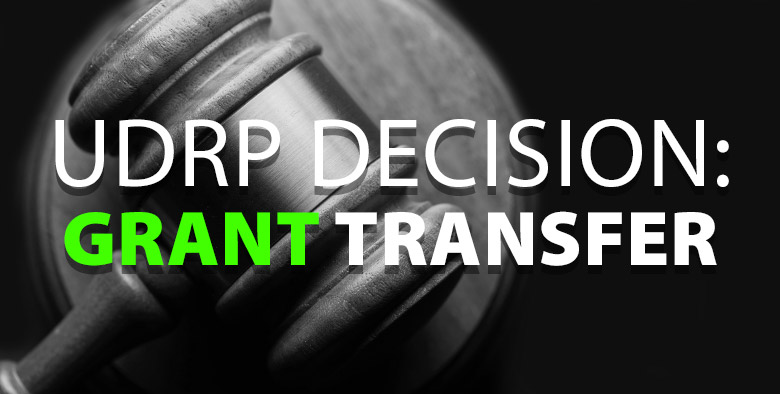The domain Lendscape.com was registered in 1999 and changed hands a few times. One might consider “lendscape” to be a typo of landscape, or an invented word about lending for the acquisition of properties.
That’s exactly what HPD Software Limited, United Kingdom thought of, apparently, securing the mark LENDSCAPE in the UK and European Union in February 2017. They filed a UDRP at the WIPO to usurp the domain.
Lendscape.com is listed on Afternic with a minimum asking price of $19,900 dollars. According to the Complainant’s claims, the domain was acquired by its current registrant and Respondent in the UDRP in March 2017.
They also pointed out that the Respondent holds more than 2,000 domain names. Of course, owning thousands of domains for reselling is not an offense or a violation of ICANN rules automatically but the Respondent did not file a response in this UDRP.
Final decision: Grant transfer of the domain Lendscape.com to the Complainant.

HPD Software Limited v. Dvlpmnt Marketing, Inc.
Case No. D2022-02691. The Parties
The Complainant is HPD Software Limited, United Kingdom, represented by Stobbs IP Limited, United Kingdom.
The Respondent is Dvlpmnt Marketing, Inc., Saint Kitts and Nevis.
2. The Domain Name and Registrar
The disputed domain name <lendscape.com> is registered with DNC Holdings, Inc. (the “Registrar”).
3. Procedural History
The Complaint was filed with the WIPO Arbitration and Mediation Center (the “Center”) on January 25, 2022. On January 27, 2022, the Center transmitted by email to the Registrar a request for registrar verification in connection with the disputed domain name. On January 28, 2022, the Registrar transmitted by email to the Center its verification response confirming that:
(a) It is the registrar for the disputed domain name;
(b) the Respondent is listed as the registrant and providing the contact details; and
(c) English is the language of the registration agreement.
The Center verified that the Complaint satisfied the formal requirements of the Uniform Domain Name Dispute Resolution Policy (the “Policy” or “UDRP”), the Rules for Uniform Domain Name Dispute Resolution Policy (the “Rules”), and the WIPO Supplemental Rules for Uniform Domain Name Dispute Resolution Policy (the “Supplemental Rules”).
In accordance with the Rules, paragraphs 2 and 4, the Center formally notified the Respondent of the Complaint, and the proceedings commenced on February 4, 2022. In accordance with the Rules, paragraph 5, the due date for Response was February 24, 2022. The Respondent did not submit any response. Accordingly, the Center notified the Respondent’s default on February 25, 2022.
The Center appointed Warwick A. Rothnie as the sole panelist in this matter on March 7, 2022. The Panel finds that it was properly constituted. The Panel has submitted the Statement of Acceptance and Declaration of Impartiality and Independence, as required by the Center to ensure compliance with the Rules, paragraph 7.
To clarify certain dates in the case chronology, the Panel issued Administrative Panel Order No. 1 on March 22, 2022 pursuant to paragraph 12 of the Rules inviting the Complainant to submit a supplemental filing to address these matters. The Administrative Order also made provision for the Respondent to submit an answering supplemental filing if the Complainant availed itself of the invitation.
In the event, the Complainant submitted a supplemental filing on March 25, 2022. Despite provision for a supplemental filing in answer, the Respondent did not file any material in response.
4. Factual Background
The Complainant was founded in 1972. The Complainant was originally incorporated as Hill Price Davison Limited but changed its name to HPD Software Limited in 2000.
Since February 27, 2017, it has been providing software under or by reference to the trademark “Lendscape” for some 135 financial services providers in the United Kingdom, Europe, North America, the Middle East, the Far East and sub-Saharan Africa. Its clients include HSBC and Deutsche Bank. It has offices in the United Kingdom, North America and Australia.
For the financial year ending October 2019, the Complainant’s turnover was almost GBP 16 million. For the year ending October 2020, its turnover was in excess of GBP 17 million.
Amongst other things, the Complainant has registered trademarks:
(a) United Kingdom Registered Trademark No. UK00003215446, LENDSCAPE, which was registered on July 7, 2017 (with effect from February 27, 2017 its filing date);
(b) European Union Trademark No. 016751695, LENDSCAPE, which was registered on December 22, 2017 (with effect from May 18, 2017);
(c) United States Registered Trademark No. 5,457,128, LENDSCAPE, which was registered in the Principal Register on May 1, 2018; and
(d) Australian Registered Trademark No 1828579, LENDSCAPE, which was registered on January 10, 2018 (with effect from February 28, 2017).
All of these trademarks are registered in respect of a range of goods and services in International Classes 9, 35, 38 and 42. The United Kingdom, European Union and United States registered trademarks are also registered in International Class 36.
The disputed domain name was first registered on February 15, 1999.
According to WhoIs records, however, the disputed domain name appears to have been first registered in the Respondent’s name on March 22, 2017.
Shortly before the Complaint was filed, the disputed domain name resolved to a “parking page”, headed “Buy this Domain” which also displayed pay-per-click (PPC) links related to financial services and software and software systems for use in providing financial services – for example, a link promoting a mortgage payment processing system. If one clicks on the “Buy this Domain” link, one is taken to a page on the <saw.com> website which states “lendscape.com Is For Sale” and invites the browser to submit an offer.
5. Discussion and Findings
No response has been filed. The Complaint and Written Notice have been sent, however, to the Respondent at the electronic and physical coordinates confirmed as correct by the Registrar in accordance with paragraph 2(a) of the Rules. The courier attempting delivery of the Written Notice was unable to complete delivery. Bearing in mind the duty of the holder of a domain name to provide and keep up to date correct WhoIs details, therefore, the Panel finds that the Respondent has been given a fair opportunity to present his or its case.
When a respondent has defaulted, paragraph 14(a) of the Rules requires the Panel to proceed to a decision on the Complaint in the absence of exceptional circumstances. Accordingly, paragraph 15(a) of the Rules requires the Panel to decide the dispute on the basis of the statements and documents that have been submitted and any rules and principles of law deemed applicable.
Paragraph 4(a) of the Policy provides that in order to divest the Respondent of the disputed domain name, the Complainant must demonstrate each of the following:
(i) the disputed domain name is identical or confusingly similar to a trademark or service mark in which the Complainant has rights; and
(ii) the Respondent has no rights or legitimate interests in respect of the disputed domain name; and
(iii) the disputed domain name has been registered and is being used in bad faith.
A. Identical or Confusingly Similar
The first element that the Complainant must establish is that the disputed domain name is identical with, or confusingly similar to, the Complainant’s trademark rights.
There are two parts to this inquiry: the Complainant must demonstrate that it has rights in a trademark at the date the Complaint was filed and, if so, the disputed domain name must be shown to be identical or confusingly similar to the trademark.
The Complainant has proven ownership of the registered trademark LENDSCAPE as identified in section 4 above.
The second stage of this inquiry simply requires a visual and aural comparison of the disputed domain name to the proven trademarks. This test is narrower than and thus different to the question of “likelihood of confusion” under trademark law. Therefore, questions such as the scope of the trademark rights, the geographical location of the respective parties and other considerations that may be relevant to an assessment of infringement under trademark law are not relevant at this stage. Such matters, if relevant, may fall for consideration under the other elements of the Policy. e.g. WIPO Overview of WIPO Panel Views on Selected UDRP Questions, Third Edition (WIPO Overview 3.0), section 1.7.
In undertaking that comparison, it is permissible in the present circumstances to disregard the generic Top‑Level Domain (gTLD) component as a functional aspect of the domain name system. WIPO Overview 3.0, section 1.11.
Disregarding the “.com” gTLD, the disputed domain name consists of the Complainant’s registered trademark. Accordingly, the Panel finds that the Complainant has established that the disputed domain name is identical with the Complainant’s trademark and the requirement under the first limb of the Policy is satisfied.
B. Rights or Legitimate Interests
The second requirement the Complainant must prove is that the Respondent has no rights or legitimate interests in the disputed domain name.
Paragraph 4(c) of the Policy provides that the following circumstances can be situations in which the Respondent has rights or legitimate interests in a disputed domain name:
(i) before any notice to [the Respondent] of the dispute, [the Respondent’s] use of, or demonstrable preparations to use, the [disputed] domain name or a name corresponding to the [disputed] domain name in connection with a bona fide offering of goods or services; or
(ii) [the Respondent] (as an individual, business, or other organization) has been commonly known by the [disputed] domain name, even if [the Respondent] has acquired no trademark or service mark rights; or
(iii) [the Respondent] is making a legitimate noncommercial or fair use of the [disputed] domain name, without intent for commercial gain to misleadingly divert consumers or to tarnish the trademark or service mark at issue.
These are illustrative only and are not an exhaustive listing of the situations in which a respondent can show rights or legitimate interests in a domain name.
The onus of proving this requirement, like each element, falls on the Complainant. Panels have recognized the difficulties inherent in proving a negative, however, especially in circumstances where much of the relevant information is in, or likely to be in, the possession of the respondent. Accordingly, it is usually sufficient for a complainant to raise a prima facie case against the respondent under this head and an evidential burden will shift to the respondent to rebut that prima facie case. The ultimate burden of proof, however, remains with the Complainant. See e.g., WIPO Overview 3.0, section 2.1.
The Complainant states that it has not authorised the Respondent to use the disputed domain name. Nor is the Respondent affiliated with it.
The disputed domain name is not derived from the Respondent’s name. Nor is there any suggestion of some other name by which the Respondent is commonly known from which the disputed domain name could be derived. From the available record, the Respondent does not appear to hold any trademarks for the disputed domain name.
The use of the disputed domain name to offer it for sale and, pending that sale, to generate revenue through PPC links does not qualify as:
(a) either a good faith offering of goods or services under the Policy. See e.g. WIPO Overview 3.0 section 2.9;
(b) nor is it a legitimate noncommercial or fair use for the purposes of paragraph 4(c)(iii) of the Policy. See e.g. WIPO Overview 3.0, section 2.5.3.
These matters, taken together, are sufficient to establish a prima facie case under the Policy that the Respondent has no rights or legitimate interests in the disputed domain name. The basis on which the Respondent has adopted the disputed domain name, therefore, calls for explanation or justification. The Respondent, however, has not sought to rebut that prima facie case or advance any claimed entitlement. Accordingly, the Panel finds the Complainant has established the second requirement under the Policy also.
C. Registered and Used in Bad FaithUnder the third requirement of the Policy, the Complainant must establish that the disputed domain name has been both registered and used in bad faith by the Respondent. These are conjunctive requirements; both must be satisfied for a successful complaint: see e.g. Burn World-Wide, Ltd. d/b/a BGT Partners v. Banta Global Turnkey Ltd WIPO Case No. D2010-0470.
Generally speaking, a finding that a domain name has been registered and is being used in bad faith requires an inference to be drawn that the respondent in question has registered and is using the disputed domain name to take advantage of its significance as a trademark owned by (usually) the complainant.
Although the disputed domain name was first registered in 1999, the relevant date for this assessment is the date the Respondent first became the registrant. See e.g. WIPO Overview 3.0, section 3.9.
The Respondent became the registrant in late March 2017, about one month after the Complainant launched its service under the LENDSCAPE trademark and also filed its first trademark application.
That launch was accompanied by press coverage.
The Complainant contends that the Respondent registered the disputed domain name with knowledge of the Complainant’s trademark with the intention of taking advantage of its significance as a trademark.
While LENDSCAPE differs from “landscape” only by one letter, it both looks and sounds different and, being meaningless, does not convey the same “idea”. For present purposes, therefore, the trademark LENDSCAPE is an invented or coined term which has no apparent significance apart from its use as a trademark. The term has no association with the Respondent and no apparent connection with the Respondent’s activities. In that connection, the Complainant has provided evidence that the Respondent holds registrations of over 2,000 other domain names.
The Respondent has made no attempt to rebut the Complainant’s allegations or otherwise to explain how the Respondent derived the disputed domain name.
In these circumstances, therefore, it appears that the Respondent has adopted the disputed domain name because of its trademark significance. Accordingly, as the Respondent has not sought to claim, let alone establish, that he or she has rights or legitimate interests in the disputed domain name, the Panel finds the Respondent has registered it in bad faith. The offering of the disputed domain name for sale which using it to derive revenues from PPC links capitalizing on its trademark significance also constitutes use in bad faith under the Policy.
Accordingly, the Complainant has established all three requirements under the Policy.
6. Decision
For the foregoing reasons, in accordance with paragraphs 4(i) of the Policy and 15 of the Rules, the Panel orders that the disputed domain name <lendscape.com> be transferred to the Complainant.
Warwick A. Rothnie
Sole Panelist
Date: April 4, 2022











